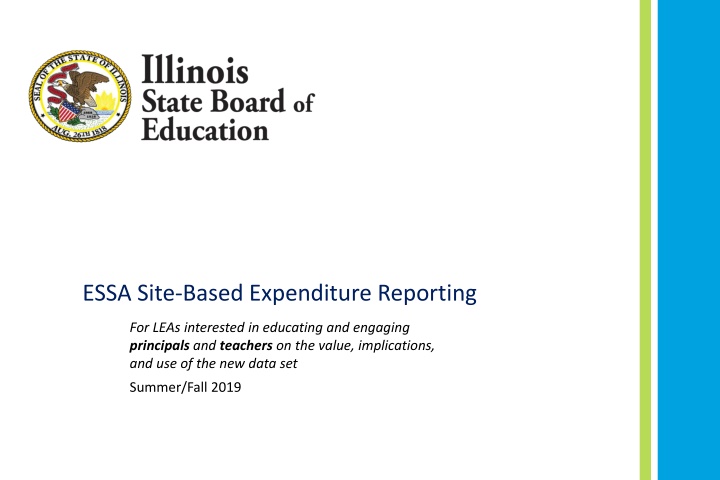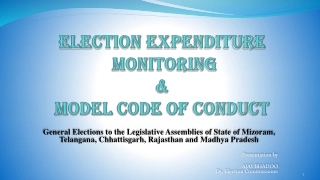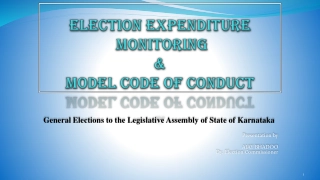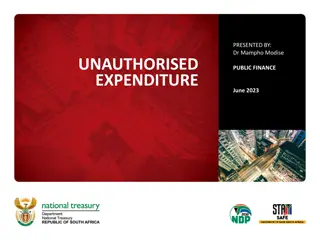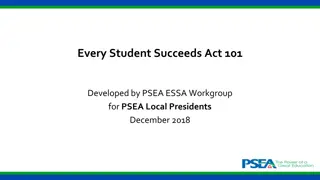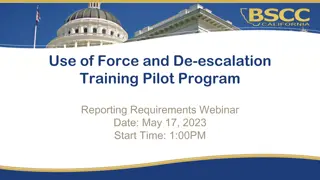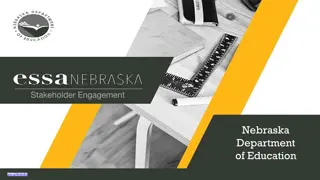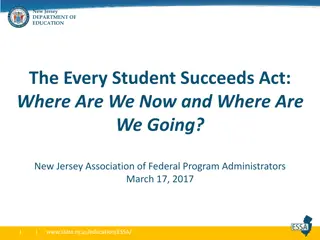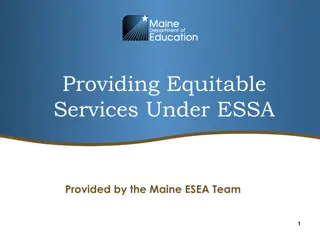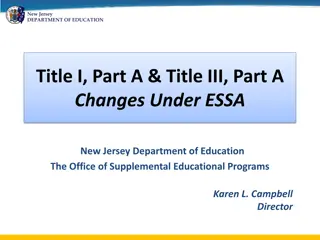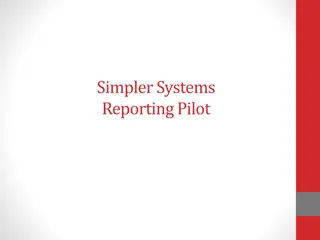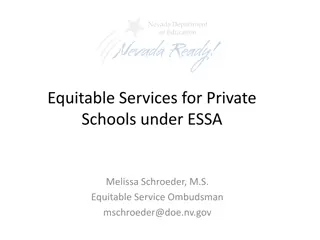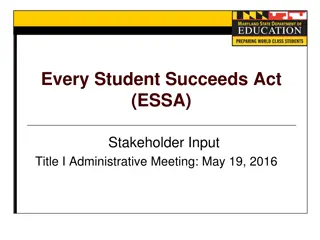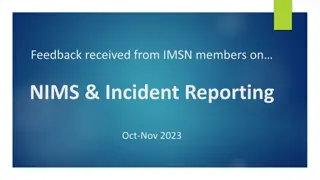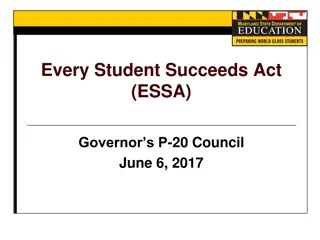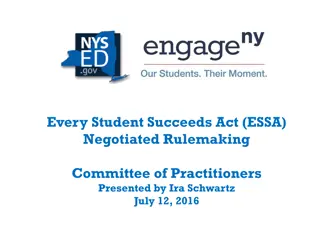ESSA Site-Based Expenditure Reporting
ISBE developed this document as an optional resource for superintendents/leadership teams to facilitate discussion and communication within their districts about site-based expenditure reporting. It aims to engage principals and teachers in understanding the value of this reporting, its implications, and how it can inform district work. The document includes sample slides and verbal talking points for district leaders to use in conversations with stakeholders. It also suggests actions for initial data analysis, awareness communications, preparation for report card release, and deeper engagement discussions.
Download Presentation

Please find below an Image/Link to download the presentation.
The content on the website is provided AS IS for your information and personal use only. It may not be sold, licensed, or shared on other websites without obtaining consent from the author.If you encounter any issues during the download, it is possible that the publisher has removed the file from their server.
You are allowed to download the files provided on this website for personal or commercial use, subject to the condition that they are used lawfully. All files are the property of their respective owners.
The content on the website is provided AS IS for your information and personal use only. It may not be sold, licensed, or shared on other websites without obtaining consent from the author.
E N D
Presentation Transcript
ESSA Site-Based Expenditure Reporting For LEAs interested in educating and engaging principals and teachers on the value, implications, and use of the new data set Summer/Fall 2019
Purpose of this document 2 ISBE developed this document as an optional resource for superintendents/ leadership teams to use to facilitate discussion and communication within their districts about site-based expenditure reporting, with the specific goal of engaging principals and teachers, if appropriate for the LEA. This communication should take place within the broader context of site-based expenditure data analysis and engagement planning. Contained herein are sample slides that could guide conversation in your district about the value of this reporting, its potential implications, how it may inform district work, and how principals and teachers can support effective use of expenditure data. The slides are written from the perspective of a district leader and can (and should) be adjusted to each district s context. In the notes section of these slides, some verbal talking points are suggested to supplement information contained on the slides. For questions or feedback regarding this resource or anything else related to site- based expenditure reporting, please reach out to site-based@isbe.net.
This document may fit as part of the LEAs broader work on data analysis and engagement 3Recommended action area Context Initial data analysis (summer Sept) District leadership teams should explore expenditure data alongside contextual data like student needs and outcomes, in pursuit of questions related to alignment with district strategy, resource equity, relationship between resources and academic outcomes, and/or opportunities for best practice sharing. Document initial findings and areas for future exploration. Initial awareness communications (summer Sept) Districts have the opportunity to begin telling their story through internal communications and stakeholder engagement ahead of the Report Card release. Suggested actions include: 1. Utilize this slide deck to inform principals of the upcoming data release and the district s anticipated use of the data, and invite them to engage in the data analysis process. Principals are key, trusted resources for parents and communities and also have important insight into resource use. For both these reasons, it is highly recommended that principals are actively engaged in the data analysis process. 2. Utilize appropriate parts of this deck to inform teachers and other staff on the data release, ensuring they are equipped with essential information to respond to any community questions, including contact information for district personnel with whom community members can discuss data. You are here
This document may fit as part of the LEAs broader work on data analysis and engagement 4 Recommended action area Context Preparation for Report Card release (Sept) Suggested actions include: 1. Prepare a press release, if appropriate, to coincide with Report Card release 2. Prepare audience-specific communications (parents, media, etc.) to support the press release Engaging in deeper conversations (Oct Dec) It is recommended that districts thoroughly analyze expenditure data (not solely within finance) with an eye toward the value of this reporting, identifying key questions to unpack in internal analysis and conversations. Districts may consider the appropriate forum to review these data prior to or after public release, and to engage the appropriate stakeholders (internal/external) in various conversations. District leaders are encouraged to reach out to peers, statewide orgs, ISBE, and/or others for resources around facilitation. Application to SY20-21 planning and budgeting (Jan spring) It is recommended that districts utilize outcomes of analyses to inform resource allocation priorities for SY20-21 budgeting. They may also invite, as appropriate, stakeholders to engage in conversations on resource allocation implications in preparation for SY20-21 budgeting.
5 Content Overview
Todays Goals 6 After today s discussion, our district will: Understand this reporting requirement and be able to communicate the basics about it to stakeholders Have a shared understanding of what to expect when reporting is made available, including questions we may be asked by the community Know what steps we can take to use these data within our district Work alongside you as our district engages in this important work
Site-based expenditure reporting will provide new insights and raise new questions 7 For most districts across the country, site-based expenditure reporting provides districts with the opportunity to look at financial data at the school level for the first time These data will likely raise many questions We will need to work together to understand the data, and make changes to our policies and practices if necessary Your engagement will help our district make the most of this new data opportunity
8 ESSA Financial Transparency
ESSA Site-Based Expenditure Reporting must be implemented for SY2018-19 9 ESSA requires that State Education Agencies report school-by- school spending per pupil for every district on their Report Card. All expenditures at the district, including centralized expenditures, must reported. The per-pupil expenditures of Federal, State, and local funds, including actual personnel expenditures and actual non-personnel expenditures of Federal, State, and local funds, disaggregated by source of funds, for each local educational agency and each school in the State for the preceding fiscal year.
10 Site-Based Expenditure Reporting Approach
ISBEs plan for SY2018-19 has been developed with the input of an Advisory Group 11 Seeking to make site-based expenditure data meaningful, rather than a compliance exercise, ISBE engaged an Advisory Group of superintendents, business officials, and advocates from across the state to guide planning and development As the process has evolved, representatives from various organizations, including advocacy organizations and membership associations, have provided important input from their unique lens into implementation planning for this requirement All public materials from the process are available on ISBE s website at www.isbe.net/site-based
Key Components of the Advisory Groups Value Proposition 12 Resource allocation will be more readily accessibleto schools and stakeholders Empowers LEAs and communities to assess and improve equity EnablesLEAs and communities to gaina better understanding of the relationship between student outcomes and financial resources Enables LEAs, schools, and the state to identify evidence-based best practices and opportunities to foster innovation between peers Which of these value proposition bullet points most resonates with you? If you could see what we were spending by site, how would you want to use that information?
13 What will be reported, where, and when?
With the input of the Advisory Group, ISBE issued Site-Based Expenditure Reporting guidance document available at www.isbe.net/site-based 14 This guidance provides general instructions on how to meet the reporting requirement and answers the following questions: 1. What does the reporting look like? 2. Which entities must report? 3. What expenditures must be included / should be excluded? 4. What student count should be used? Are there any exceptions? 5. How do we handle special circumstances, such as students educated outside the district or charter schools? 6. What are alternatives and recommendations for handling centralized expenditures?
By following the guidance, districts will be able to calculate total per-pupil expenditures for any given school site 15 Per-pupil expenditures reported for each school shall comprise:
By following the guidance, districts will be able to produce this data table showing what ISBE will collect from LEAs 16 See footnote below (A+B)/ C C A / C B / C D Based on input from the Advisory Group, this level of reporting detail is the only mandated collection for Year 1. Exclusions: Certain expenditures should be excluded from the total expenditures reported. The intent behind these exclusions is to: 1. reflect expenditures for pre-K through 12th grade students being served or placed by the Reporting Entity and 2. reflect expenditures that are largely ongoing, normal course resource allocations. See Reporting Guidance at www.isbe.net/site-based for a full listing of excluded expenditures.
Data will be visualized on School and District Report Cards, to be released in October 2019 17 Data visualization provides target audiences with the data they need to investigate their critical questions toward realizing the value proposition Target audiences = district leaders, principals, teachers, parents & families, and community members Visualizations, which were developed with input from the Advisory Group, will be included on the Illinois Interactive Report Card in the forms of charts, graphs, and tables on various pages Districts may optionally include district-developed narrative alongside these visualizations Explanations of visualizations will direct community members to discuss reported data directly with districts, and not necessarily with ISBE ISBE and its Advisory Group of practitioners assumed that these data points are most impactful at the local level and that districts are best positioned to explain them and their implications
Checking common sources of confusion 18 T/F: Site-based expenditure reporting is only required for schools receiving Title funding T/F: Districts must include actual salaries of school-based positions in site-based expenditure reporting T/F: Site-based expenditure reporting does not include central expenditures like transportation or central office supports T/F: Site-based expenditure reporting will be shared publicly on the Illinois Report Card T/F: Community members should ask questions about reporting data to the State (ISBE)
19 Implications for Our District
Site-based expenditure reporting will provide new insights and raise new questions 20 For most districts across the country, site-based expenditure reporting provides districts with the opportunity to look at financial data at the school level for the first time These data will likely raise many questions We will need to work together to understand the data and to make changes to our policies and practices if necessary Your engagement will help ensure our district makes the most of this new data opportunity
Example: What if our districts site-level per-pupil data looked like this? 21 Highest free/reduced-price lunch percentage Lowest avg. teacher salary; highest special education percentage $20,000 $19,004 $18,000 Highest enrollment school $16,996 $16,980 $16,140 $16,000 $14,858 $14,786 $14,682 $14,651 $13,997 $13,968 $13,841 $13,613 $13,578 $14,000 $12,973 $12,694 $12,000 $10,000 $8,000 $6,000 $4,000 $2,000 $0 School A School B School C School D School E School F School G School H School I Schhol J School K School L School M School N School O Magnet School Highest avg. teacher salary Lowest enrollment school
What questions might we ask of these data? 22 District Goals and Values: How do these data align to our district s goals and values? Equity: Do these data reflect equitable allocation of resources? Outcomes: Do academic outcomes seem to be related to resource allocation? Best Practices: Are there any best practices to share that could improve effectiveness or efficiency in our use of resources? What resonates with you? What else would you want to ask or learn from the data?
23 What can you expect next?
District Considerations 24 As we approach reporting time, we will consider the following questions: What may site-based expenditure data tell us as a district? What opportunities do these data provide for our district? What futurediscussions might be valuable for our district in advance of this reporting on state and school report cards? What communications work should our district consider planning? What contextual data would be helpful alongside site-based expenditure data? This is just the beginning of a conversation. Your engagement in future discussions will help us achieve the intended value of this reporting.
Communications Key Points 25 You may receive questions from parents and community members about this new reporting initiative. Here are key points that may be helpful when explaining the new data: Site-based expenditure reporting is required due to a new federal law (the Every Student Succeeds Act) All districts need to report spending by school for all schools in the district This reporting will be publicly available beginning with SY18-19 data on the Illinois Report Card published in the fall of 2019 Because this is the first year of public reporting, we may have a lot to learn from these new data points. They will provide our district with the opportunity to evaluate our resource allocation through the lens of equity, to identify connections between spending and academic outcomes, and to identify best practices You can reach out to NAME at our district for further information, or visit ISBE s site-based reporting website at www.isbe.net/site-based
ISBE is offering training and resources for this reporting 26 All site-based expenditure reporting resources are located at www.isbe.net/site-based. While many of these resources are targeted toward business officials and superintendents, they are publicly available to everyone. If you would like to learn more, consider reviewing this document for a deep dive: Site-Based Expenditure Reporting Guidance This document details what LEAs must prepare in order to fulfill the site-based expenditure reporting requirement. It comes with a corresponding introductory letter from State Superintendent Dr. Carmen Ayala.
Questions? 27 What questions, concerns, or thoughts do you have?
28 Supplemental Slides
Site-Based Expenditure Reporting fits into statewide education goals and initiatives 29 ESSA State Plan: Whole child whole school whole community and IL-EMPOWER Evidence-Based Funding: new funds, mindsets of equity & adequacy, annual spending plans Illinois Data FIRST grant: federal funding for implementing site- based expenditure reporting and the educator dashboard Ed360 Fiscal and Academic Solvency: academic and financial needs go hand-in-hand
ISBEs plan for SY2018-19 was developed with the input of an Advisory Group, including these original members: 30 Mark Jontry president, Illinois Association of Regional Superintendents of School; regional superintendent of schools, Regional Office of Education 17 Joseph McDonnell treasurer, Bremen Township School Treasurer s Office Cameron Mock director of fiscal policy and analysis, Chicago Public Schools Ginger Ostro executive director, Advance Illinois Dean Romano chief operating officer and chief school business official, Yorkville CUSD 115 Diane Rutledge executive director, Large Unit District Association Lisa Schuchart commissioner, Illinois State Charter School Commission Edwin Shoemate superintendent, Cobden Unit SD 17; president-elect, Board of Association of Illinois Rural and Small Schools Mark Twomey superintendent, Macomb CUSD 185 Steve Webb superintendent, Goreville CUSD 1 Dave Wood chief financial officer, Bloomington SD 87 Dave Ardrey executive director, Association of Illinois Rural and Small Schools Jon Bartelt superintendent, Bloomingdale SD 13 Michael Bradley chief financial officer, ACERO Schools Nick Cavaliere certified public accountant, Baker/Tilly Brent Clark executive director, Illinois Association of School Administrators John Correll superintendent, Salt Creek SD 48 Brad Cox superintendent, Erie CUSD 1 Mark Doan superintendent, Effingham Unit SD 40 Roger Eddy executive director, Illinois Association of School Boards Bob Green superintendent, Collinsville CUSD 10 Rich Haglund chief operating officer, Illinois Network of Charter Schools Lindsey Hall superintendent, Mahomet-Seymour CUSD 3 Susan Harkin chief operating officer and chief school business official, District 300 Michael Jacoby executive director, Illinois Association of School Business Officials Note: Titles and members listed are as of beginning of Advisory Group engagement in Summer 2017. ISBE is grateful to those who have joined along the way, too.
